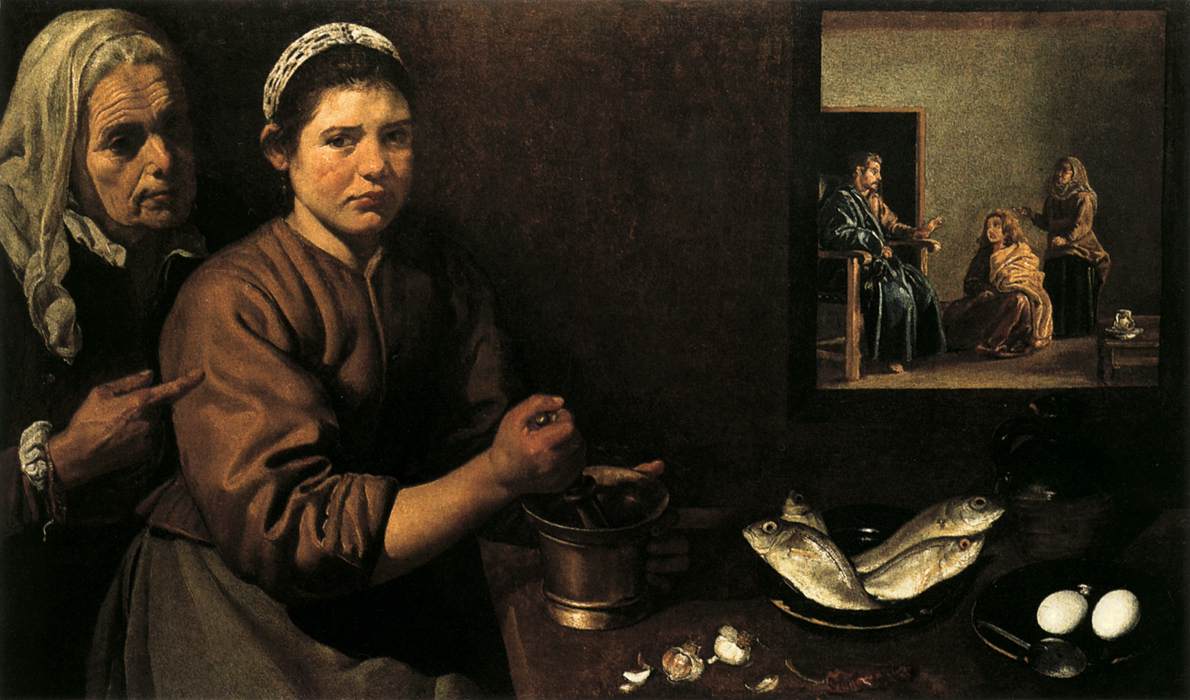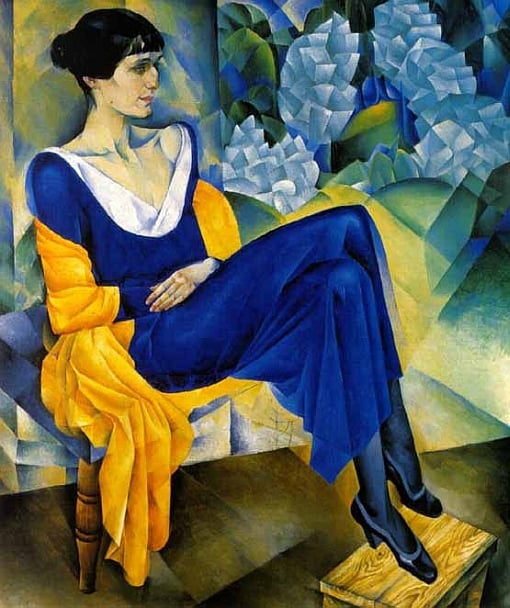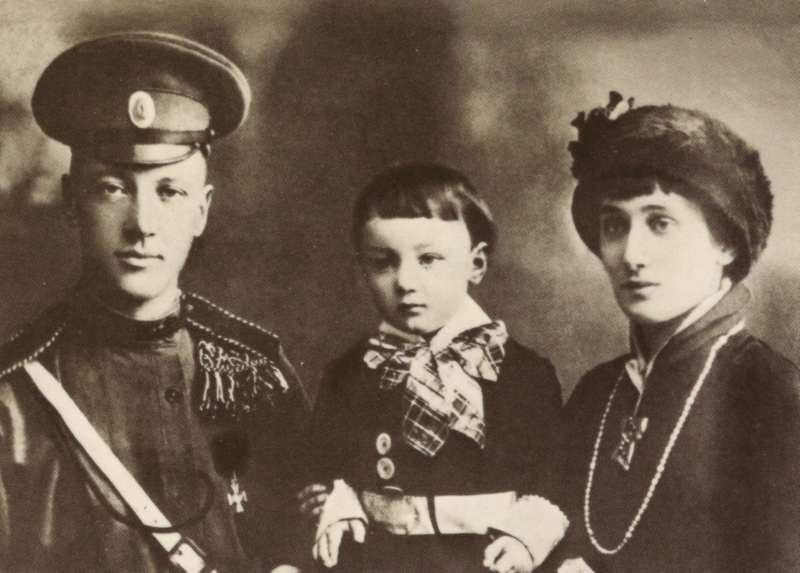.

Kitchen Scene with Christ in the House of Martha and Mary: Diego Rodriguez de Silva y Velázquez (1599-1660), c. 1618, oil on canvas, 60 x 103.5 cm (National Gallery, London)
Weep not for me, mother. I am alive in my grave. 1. A choir of angels glorified the greatest hour, The heavens melted into flames. To his father he said, 'Why hast thou forsaken me!' But to his mother, 'Weep not for me. . .' [1940. Fontannyi Dom] 2. Magdalena smote herself and wept, The favourite disciple turned to stone, But there, where the mother stood silent, Not one person dared to look. [1943. Tashkent]
Anna Akhmatova: Crucifixion, 1.10.7 from Requiem, 1935-1940 (first published in 1963, but not in complete form until 1987); translation by Sasha Soldatow, 1993

Portrait of Anna Akhmatova: Natan Altman, 1914, oil on canvas (State Russian Museum)
Nikolai Gumilev (1886-1921), Lev Gumilev (1912-1992) and Anna Akhmatova (1889-1966): photographer unknown, 1913 or 1916

Kitchen Scene with Christ in the House of Martha and Mary (detail): Diego Rodriguez de Silva y Velázquez (1599 - 1660), c. 1618, oil on canvas, 60 x 103,5 cm (National Gallery, London)

Kitchen Scene with Christ in the House of Martha and Mary (after 1969 restoration): Diego Rodriguez de Silva y Velázquez (1599-1660), c. 1618, oil on canvas, 60 x 103.5 cm (National Gallery, London)

...to hear beyond ...the time ... the abilities...
ReplyDeleteThe painter who did the blue Akhmatova is the same fellow whose temporary revolutionary art can be seen in the top image here.
ReplyDeleteInteresting to consider (talking of painters) that the genius Velázquez rendered the Kitchen Scene with Christ at the House of Martha and Mary when he was nineteen.
(Perhaps it is good that skateboards had not yet been invented.)
Her hand against the blue dress is beautiful. And the Velasquez...
ReplyDeleteThe faces of Russian mothers must have been monstrous books to leaf through.
Jesus absent from labour's scene, framed up as a picture on the wall.
ReplyDeleteSomething here puts me in mind of Adorno and Horkheimer's reading of the Siren's episode - the oarsmen with their ear's plugged up to beauty/culture.
On that, this --
ReplyDelete"The small religious vignette in the upper right-hand corner of the picture, so pointedly juxtaposed with the foreground scene, illustrates a story told in the Gospel of Saint Luke:
"'Now it came to pass as they were on their journey that the Lord entered a certain village; and a woman named Martha welcomed him to her house. And she had a sister called Mary, who also seated herself at the Lord’s feet, and listened to his word. But Martha was busy about much serving. And she came up and said, "Lord, is it no concern of thine that my sister has left me to serve alone? Tell her therefore to help me." But the Lord answered and said to her, "Martha, Martha, thou art anxious and troubled about many things and yet only one thing is needful. Mary has chosen the best part, and it will not be taken away from her."'
"Velazquez’s picture reflects on this story and on the role of housework – and housewives – in the Christian scheme of things. But its precise meaning is not clear, and has been the subject of debate. Some commentators believe that the pouting young woman in the foreground is Martha herself, and that the picture’s two scenes show two different moments in the gospel narrative. Others argue that Velazquez meant her to be seen as an updated, contemporary equivalent to Martha, who needs to learn the same lesson as her biblical forebear – as the wise old woman next to her, with her pointing forefinger, appears to indicate. This second explanation seems more likely to be correct. It explains the otherwise puzzling presence of the old woman, not mentioned in the Bible, and also helps to account for the differences in appearance and costume between the girl in the kitchen and the smaller, remonstrating figure of Martha with Christ.
"The religious scene in the background has been another cause of disagreement. Is it, as some believe, a view through a wall into another room; or a reflection in a mirror; or a framed painting hanging on the wall? The border that surrounds it is ambiguous. The dark diagonal lines visible at each lower corner of the surround may have been intended to suggest a stone aperture, rendered in perspective; but those same slanting lines might just as well describe the joinery of a basic mirror or picture frame. My own view is that the religious scene is a painting-within-the-painting, and that Velazquez indicated this explicitly by depicting the figures and objects within it in a quite different style from the rest.
[continues]
ReplyDelete"The moral of the work is related to traditional Christian interpretations of the story of Mary and Martha. According to the venerable authority of Saint Augustine, Martha’s concern about the work involved in preparing a meal for the Lord established her as the archetype of the vita activa, or active life; whereas Mary’s desire to sit at Christ’s feet and listen to his words made her the archetype of the vita contemplativa, or spiritual life. They were not to be contrasted as bad and good but, rather, as better and best. Christ’s message to Martha, according to Augustine, was not that she should want to give up her work, which was valuable, but that she should not begrudge her sister’s more contemplative disposition – and should seek to cultivate a similar spirit of contemplation in herself. The story became particularly important to the Counter-Reformation Catholic Church, according to which Mary stood for faith and Martha for good works. Catholics believed that both works and faith were necessary aspects of a Christian life – whereas Lutherans and other Protestants insisted on the primacy of faith alone.
"The need to combine works and faith is Velazquez’s theme – and one powerfully implicit in his use of paint itself. His sense of the dignity and value of the woman’s work is conveyed by the solemnity with which he has depicted the foodstuffs and utensils before her. By bringing such weight of attention to bear on these ordinary things, he insists on their consequence, and on the value of her toil (something which the working girl herself has plainly lost sight of). The artist also suggests that even in the apparent prison of her laborious kitchen existence this modern Martha might, if she cared to look, find matter for spiritual contemplation. The austere and simple meal, painted with such sharp and intense immediacy, has a numinous quality which is reinforced by its symbolism. The fish is an ancient symbol of Christ, while eggs are time-honoured symbols of the Resurrection. She is discontented for the moment, but the girl in the kitchen has all she needs. Food for the body can also be food for the soul."
Andrew Graham-Dixon on Diego Velázquez’s Kitchen Scene with Christ in the House of Martha and Mary